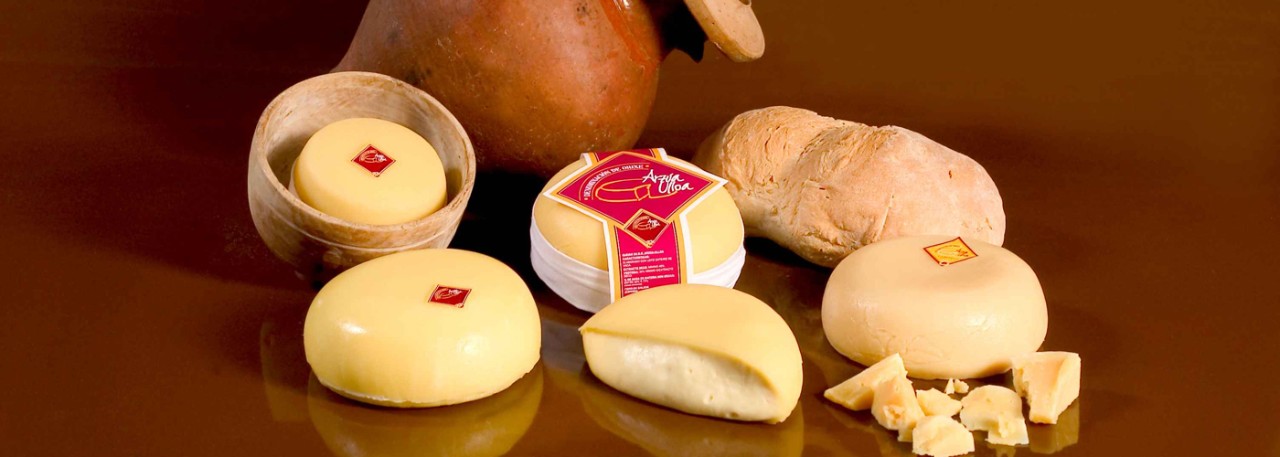.png.transform/rendition-xs/image_image%20(1).png)
Arzúa-Ulloa PDO
Cheese made from raw or pasteurized cow's milk from the Rubia Gallega, Friesian and Parda-Alpina breeds and cross-breeds, with a minimum 6-day ripening period.
Tasting notes
Arzúa-Ulloa cheese: a milky aroma, reminiscent of butter and yogurt, with shades of vanilla, cream and walnut, mild strength. With a basically milky flavor, slightly salty with medium to low acidity. It has a smooth, low to medium moist texture, it is not very firm and has medium elasticity. It is melting and soluble in the mouth, with a medium rubbery texture.
Arzúa-Ulloa farmhouse cheese: the physical and analytical features of this cheese are the same as described in the previous paragraph. Arzúa-Ulloa mature cheese: a very intense, milky aroma, with a distinctive strong smell of slightly rancid butter. It has a penetrating and sharp smell. The cheese has a salty flavor, with low acidity and medium to low bitterness. It is predominantly buttery, with slight vanilla and nutty notes, that can fluctuate between the centre and the rind. It has a distinctive sharpness. The aftertaste is bitter, with hints of butter and vanilla.
Other notes
Arzúa-Ulloa cheese: this cheese has a minimum ripening period of six days. It is lens- or cylinder-shaped, with rounded edges, a diameter of between 100 and 260 mm and a height of between 50 and 120 mm. The height should never be greater than the radius. It normally weighs between 0.5 and 3.5 kilos. The rind is thin and elastic, medium to dark yellow, shiny, clean and smooth. It may be covered with a transparent, colorless anti-mildew emulsion. The cheese is a uniform color, ranging from ivory white to pale yellow, with a shiny appearance and no cracks; there may be a small number of small, angular or round 'eyes' scattered through the cheese.
Arzúa-Ulloa farmhouse cheese: made with cow's milk obtained only from cows belonging to the dairy where the cheese is produced. Its physical and analytical features are the same as described in the previous paragraph.
Arzúa-Ulloa mature cheese: the minimum ripening period is six months. This cheese is lens- or cylinder-shaped, sometimes with a concave top; the diameter varies between 120 and 200 mm and the height between 30 and 100 mm. The weight ranges from 0.5 to 2 kg (1.1 – 4.4 lb). It is very dark yellow in color, shiny and with a fatty appearance. The rind is not very noticeable and may be covered with a transparent, colorless anti-mildew emulsion. The cheese is dark yellow, paler at the center, very compact and with few 'eyes'. It has a hard texture, making it difficult to cut, producing cracks mainly near the outer edges, which are drier. It is homogenous and very compact to the touch. It has a high fat content and is low in moisture.
Production / Processing method
These cheeses are made using fresh whole milk from cows belonging to the Rubia Gallega, Parda-Alpina and Friesian breeds or their cross breeds, on healthy dairy farms recorded on the Designation of Origin registers. Cheese production follows the processes shown below: Coagulation: this is done with animal rennet or other coagulant enzymes authorized in the Quality Manual at a temperature of 30-35ºC, for a time that varies from 30 to 75 minutes, depending on the condition of the milk and the rennet.
Cutting and washing the curd: cutting is done so that the size of the curd granules is that of a grain of corn (5-10 mm in diameter). The curd is then washed with fresh drinking water to lower the acidity. Molding: the curd is packed into cylindrical molds of a suitable size to produce cheeses complying with the required size and weight. Pressing: the time varies depending on the pressure applied and the size of the cheeses.
Salting: this is done in the vat at the curds stage and/or by placing the cheeses in a salt solution. The solution is refrigerated to prevent undesired microbiological changes taking place. The cheeses do not stay in the salt solution for more than 24 hours.
Ripening: this is done in premises where the relative humidity is between 75% and 90% and the temperature is lower than 15ºC. The minimum ripening period is six days counting from when pressing is finished, or at the end of the salting process if the cheese has been immersed in salt solution. In the case of mature cheese, the minimum ripening period is six months. During the ripening period, the cheeses are turned and cleaned as required so they acquire their distinctive features.
To safeguard product quality and traceability, protected cheeses must normally be sold whole and in authorized packaging. However, the sale of portions is permitted, including cutting up at point of sale, provided appropriate control measures are set up to guarantee product source, origin and quality, and that it reaches consumers in perfect condition, thus preventing any kind of confusion.
Geography / Relief and climate
The geographical production area consists of gentle valleys in which the landscape typically includes an abundance of meadows and pastures. These central regions of Galicia are fairly hilly, at an altitude of over 300 meters above sea level. Average temperatures are slightly below 12ºC. Annual rainfall is around 1200 to 1700 mm which, together with the landscape described above, makes this production area especially suitable for year-round meadows, pastures and various food crops for livestock, all of which need copious amounts of rain.
Regulatory Council
Consejo Regulador de la DOP Arzúa-Ulloa
Cantón de San Roque 17-1º
15800 Melide (A Coruña)
Galicia
Tel: (+34) 981 507 653
queixo@arzua-ulloa.org
www.arzua-ulloa.org
Sources:
- Spanish Ministry of Agriculture
- Regulatory Council, Arzúa-Ulloa PDO
To safeguard product quality and traceability, protected cheeses must normally be sold whole and in authorized packaging.


- Arzúa 1
- Arzúa 2

Melide - A Coruña (Galicia)
